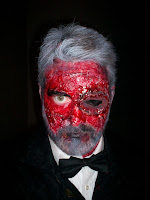 | ||
| My name is Bond... Zombie Bond. |
First off, I am not an expert, and this is merely a guide to create a basic zombie-like look. As a beginner, you will fail attempting to recreate what you've seen on The Walking Dead or pretty much any zombie movie you've ever watched. But as you practice and experiment, you will discover ways to improve your craft. I had a blast creating my own looks for two haunted house gigs between 2009-10. (And may I add that getting paid to scare people is quite possibly one of the best jobs in the world.)
But before we start, I must give a warning:
WARNING: AVOID GETTING LIQUID LATEX IN EYES, NOSE, MOUTH, ON LIPS OR IN YOUR HAIR, EYEBROWS OR FACIAL HAIR.
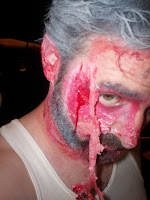 |
| Ouch. |
And with that out of the way, let's discuss the stuff you need to turn yourself into a zombie.
TOOLS:
- Bottle/container of Liquid Latex: purchased at your local costume shop or novelty store. Places like Party City (partycity.com) and Spirit Halloween (spirithalloween.com) have shops all over the U.S.
- Halloween face paint: preferably green, gray, black, white, yellow and red. You can mix black and white to create gray tones, or add black or white to darken/lighten other colors.
 |
| Removing liquid latex is like giving yourself a chemical peel. |
- Make-up sponges and cotton balls / pads / swabs.
- Fake blood: bottle or tubes. (ANOTHER WARNING: the cheap stuff may turn your skin orange or pink as you can see in the photo to the right. So make sure to read the label and seek advice from knowledgeable employees as to which brand works best.)
- Small paper cups: you pour your Liquid Latex and fake blood into these so it's easier to manage and creates less mess.
- Small electric or battery-operated fan: you can use a small desktop type one, but I prefer the hand-held battery-operated kind. This helps the Liquid Latex dry faster.
- Newspaper, old bedsheets or split-open garbage bag: to stand on and cover the sink and floor with. Creating make-up effects can be messy, especially for beginners. Plan ahead and you won't have regrets later.
- Damp paper towels or rags: you'll need to wipe stuff off your hands/fingers during the zombification process. (And if you use a washcloth or towel, make sure it's a rag and not a decorative or good one. Otherwise someone will not be happy with you. You will never be able to use that washcloth or towel again after this, except as rag.)
Now that you have your tools, get your workspace organized and make sure you have a good-sized mirror and appropriate lighting. (YET ANOTHER WARNING: once Liquid Latex dries, it is not easy to remove. If it drips on your bathroom sink or floor or carpet, be prepared to face the wrath of whomever owns said sink, floor or carpet.)
And make sure your face is freshly washed, and shave any areas where you wish to apply Liquid Latex. This includes women. There are tiny hairs all over your face, neck and ears that I promise you will bond with the Liquid Latex. So the less hair you have on the areas where you're applying latex, the less pain you'll experience later when you have to take the stuff off.
I also advise wearing an old tank top or T-shirt with the collar ripped/cut out while you're applying make-up. That way when you're done, you can just put your zombie clothes on over it. Whatever you're wearing is going to get messy if it's anywhere near your face and hands.
Oh, and you'll want to allow at least an hour for this process. You could do a rush job within 30 minutes, but it's not going to look as good because this process requires layers and Liquid Latex needs time to dry. I'm a perfectionist and after spending two seasons working as a zombie performer, I sometimes spend up to 90 minutes to create a look.
Okay, now you're ready to begin.
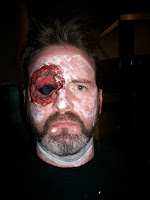 |
| Prosthetic latex piece added for effect. Don't try this on your first attempt as it adds another step to the process and requires the use of Spirit Gum. |
Apply first layer of latex on areas of the face where you wish to create texture. HINT: Do one area at a time, rather than spreading it all over your face with the first layer -- forehead, cheeks, nose, ears, chin, neck. And for the love of Jack Pierce, don't get it too close to your eyes.
STEP 2
As you apply latex, tear off pieces of one-ply tissue paper and place over latex while it is still wet.
STEP 3
Let latex and paper dry, then apply a second layer of latex. (You may want to repeat this process 3-4 times -- even adding more tissue paper -- to create more elaborate effects.)
STEP 4
After layers have dried, use your fingers to pinch, pull and stretch the latex and paper to make cuts and rips.
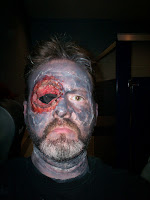 |
| A darker color was used here as the foundation because this character needed to look like he'd been burned to a cris |
Select your make-up colors (and premix them if needed), then apply foundation and colors over latex and skin, making sure to blend the edges of the latex, hairline, eyes, mouth, etc.
STEP 6
Add shading. There's no need try to anything fancy as a beginner -- just take your finger and apply black or dark gray make-up around your eyes so it looks sunken-in and zombified. With practice, you can add a little shading your cheekbones, ears, forehead, and around your nose and mouth to create a look of dimension and dilapidation. But if you're going to be playing zombie in the dark, the additional shading is unnecessary. Also during this process, I may add black color to my eyebrows so they stand out more after this next step.
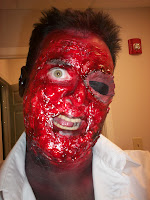 |
| Juicy! |
* Add fake blood. You can use a lot or a little depending on the look you want to create. (The look you see to the right was created solely for shock value.) Applying fake blood with a cotton swab will allow you to dab and dribble blood inside the ripped/torn areas of the textured skin you created. In turn, this will leak and trickle down your face like freshly open wounds. For more dramatic effects, pour fake blood straight from the bottle or small cup, but go slowly and start high on the sides of your face or middle of forehead to create bloody trails on your face. And you can use a cotton swab to "guide" the blood as it trickles down your face.
And viola -- 30 to 90 minutes later -- you're a zombie!
* NOTE: Step 7 is more for those who want to look like someone who has just been murdered by zombies and turned into one. To look like a zombie freshly risen from the grave, you'll want to use a gray-yellow-greenish or pale whitish-gray-yellowish color as the foundation, and blood effects should be simpler and limited to shading, bruising, and stippling (by using a textured sponge or crumpled paper towel). You can also use red and black make-up pencils to create a veiny look. After all, the blood is drained from the body before burial and replaced with embalming fluid, so going overboard on the bloody effects may cause you to look amateurish unless you're going for shock value.
If you want to view this as a step-by-step photo process (which includes the images seen here), please click here for a photo gallery of zombie make-up EFX I created for myself. Many images have a caption explaining how the effects were created.
 |
| I want his face... OFF! |
Once you've got the latex off, you'll still need to wash again, especially if your skin has been stained by fake blood. I recommend using a good facial scrub -- the kind with that beady, gritty stuff in it -- to remove any residual crud. And if you do happen to get liquid latex in your hair, I was told by BAFTA-nominated movie make-up effects master Francisco X. Perez that peanut butter works wonders to remove it. For other helpful info, visit LiquidLatex.com.
And here's a hint to help create better textures: after you've removed the latex from your face, save it! Let it dry overnight and it shrinks and bonds tightly -- making it look "aged" and deteriorated. This adds a level of realism and shock value you just can't get from a freshly-created latex look. It also then becomes a prosthetic piece you can reuse repeatedly. In the photo you see to the left, I have reused five individual pieces which, on the second use, bonded to form a mask which I was able to reuse 5-6 more times before it became impractical and nasty.
And above all, have fun with it! Be bold! Experiment! Go crazy! That's how legendary movie industry artists like Rick Baker, Howard Berger, Greg Nicotero, Lon Chaney Sr., Jack Pierce, and Dick Smith got their start. (You can learn more about their work on LISTAL.com.) I also recommend watching the STARZ 2008 documentary, Fantastic Flesh: The Art of Make-up EFX (which for you Netflix subscribers is currently available via Instant Watch).
And here's a video tutorial with a process similar to what I have described here:
http://www.youtube.com/watch?v=0uz9XStBJ6k
Source credit: The Fayetteville Feed published an article in their September 2010 issue titled "How To Be Undead," which inspired me to share my experience experimenting with make-up effects. The original article (more like a sidebar in the magazine) was an oversimplified 7-step process which I have modified and expanded by adding specific details. So other than the basic 7 steps involved, these words and images are my own.



